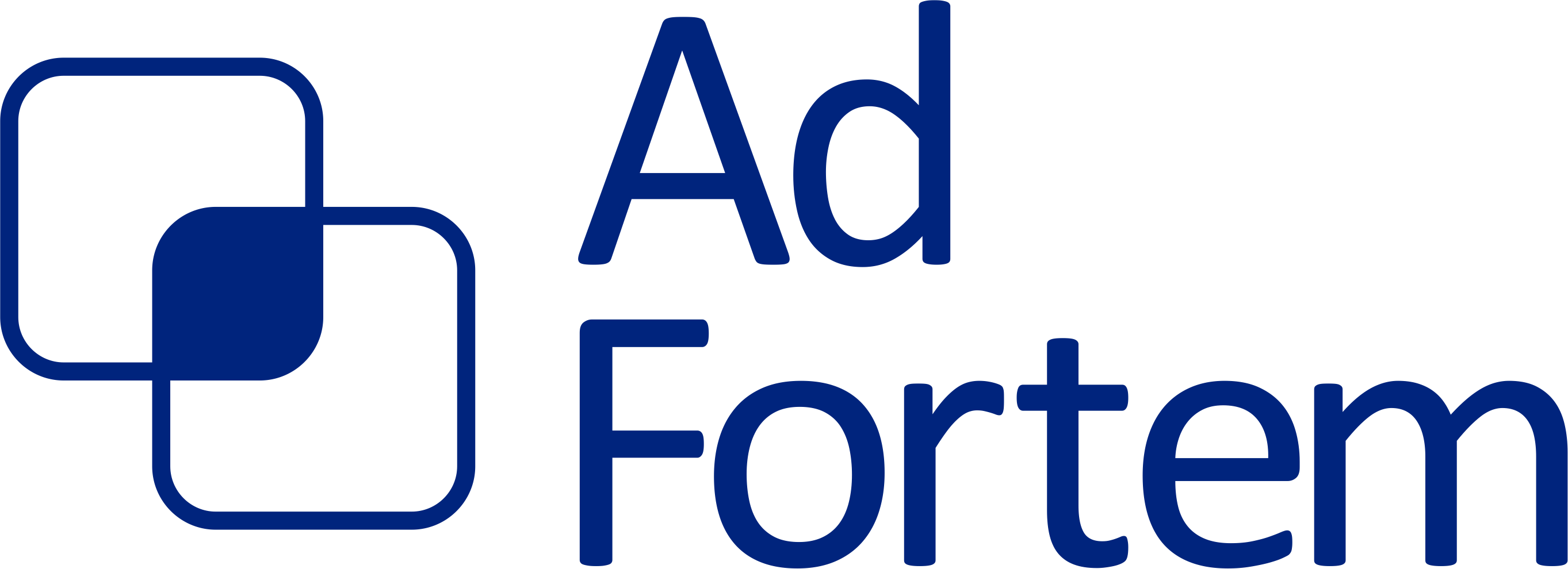

The need for accessible communication is growing worldwide, especially for the blind and visually impaired. Modern technologies such as the braille machine play a crucial role in this.
Investing in innovative braille solutions, such as Roland UV printers and Gravotech engraving machines, not only makes buildings and information more accessible but also increases inclusion in society. AdFortem offers both solutions and is happy to conduct tests for your braille signage.
Discover in this overview the 7 best braille machine options for 2025, so you can always make the right choice for optimal accessibility.
Braille is a unique script that consists of a six-dot system in which each letter, number, or symbol is represented by a combination of tactile dots. This system enables reading and writing for the blind and visually impaired. A braille machine is specifically designed to accurately apply these dots onto paper or other materials, allowing users to read texts independently.
Traditional braille machines work mechanically. They have six keys, each activating a point in the braille cell. By pressing different keys simultaneously, a specific letter is formed. Modern digital solutions go further: they convert digital text into tactile braille dots, for example on refreshable braille displays or via advanced printing and engraving machines. This makes braille machines increasingly versatile.
The difference between mechanical and electronic braille machines lies mainly in functionality and ease of use. Mechanical braille machines are robust and simple, ideal for education and daily use. Electronic versions offer digital storage, voice support, and connectivity. Both types are used in education, workplaces, and public spaces. In Belgium and the Netherlands, thousands of active braille users can function independently thanks to this technology.
The latest technological innovations make it possible to produce braille signage and information panels professionally. Roland UV printers can print braille on various materials, from plastic to metal, with high precision and durability. Gravotech engraving machines allow braille to be permanently and wear-resistant engraved into materials such as aluminum and stainless steel. AdFortem provides both Roland UV printers and Gravotech engraving machines for braille signage and is happy to conduct tests for your project to ensure the right solution is chosen.
Legislation around braille signage is becoming increasingly strict. Europe sets minimum accessibility standards with EN 17210, while Belgium and the Netherlands impose specific requirements for braille in public buildings. Sectors such as public transport, hospitals, and government institutions must provide braille signage. In countries like France, Germany, and the United Kingdom, this is already a legal requirement. This underscores the growing importance of braille machines and the pursuit of an inclusive society where everyone can participate independently.
Accessible communication is essential for an inclusive society. A braille machine plays a central role in this because braille makes information tactile and readable for the blind and visually impaired. But how exactly does braille work, and what does the law say about it?
Braille is a tactile reading system that uses a six-dot code. A braille machine converts texts into tactile dots, allowing users to read information independently. In public buildings, schools, and companies, the use of braille is becoming increasingly visible, partly thanks to technological advancements such as Roland UV printers and Gravotech engraving machines.
The European standard EN 17210 forms the basis for accessibility in the built environment. This guideline sets clear requirements for braille signage, ensuring that information is accessible everywhere. Belgium and the Netherlands follow this standard and have added national obligations. In both countries, public buildings, transport hubs, and healthcare institutions are required to provide braille signage. This also applies to elevators, door plates, and information panels.
Some European countries are further along in implementation. In France and Germany, braille signage is legally required in public spaces. The United Kingdom has similar regulations. As a result, the importance of braille machines is growing across Europe. In the Netherlands and Belgium, requirements are becoming stricter toward 2025 and the obligation is expanding to more sectors, including education and industry.
Practical examples show that technology makes a difference. Roland UV printers can print braille on various materials, such as plastic and aluminum. This is ideal for signage, nameplates, and labels. Gravotech engraving machines produce precise and durable braille dots in hard materials. Both technologies support different braille standards and allow customization, whether for a single door plate or large information panels.
AdFortem, as a specialist, offers both solutions and guides companies and institutions in choosing the right braille machine. They are happy to conduct on-site tests to ensure optimal results. Learn more about advice, demonstrations, and test productions on Braille Solutions Advice.
Accessibility is becoming a growing priority worldwide. In the coming years, stricter requirements and new innovations will ensure that the braille machine remains indispensable in every modern environment. By investing in the right technologies and complying with legislation, companies and institutions contribute to an inclusive and future-proof society.
Accessible communication is essential in an inclusive society. Braille enables blind and visually impaired people to read information independently. The six-dot braille system is increasingly integrated into public spaces, schools, and businesses through modern technologies.
The European standard EN 17210 and national legislation in Belgium and the Netherlands increasingly require braille signage in public buildings. In countries like France, Germany, and the United Kingdom, braille signage is already legally required in specific locations. This highlights the growing global importance of innovative braille machine solutions for signage and information panels.
Roland UV printers provide an advanced way to apply braille on various materials such as plastic, metal, and plexiglass. UV curing creates a durable and wear-resistant relief, ensuring braille remains readable for a long time. This technology is ideal for producing signage, nameplates, and labels in small and large runs.
The benefits of a Roland UV printer for braille signage include:
For companies seeking a professional braille machine, these printers are highly suitable. More information can be found at UV Printers for Braille Signage.
Gravotech engraving machines allow braille to be durably engraved into hard materials such as aluminum, stainless steel, or plastic. The result is precise, tactile braille dots resistant to heavy use. This makes engraving particularly suitable for permanent applications such as door plates, elevator panels, and industrial markings.
Comparison of printing vs. engraving for braille signage:
| Feature | Printing (UV) | Engraving (CNC) |
|---|---|---|
| Materials | Versatile | Metal, plastic |
| Durability | High | Very high |
| Customization | Flexible | Highly precise |
| Run size | Small/large | Specific, custom |
A Gravotech braille machine enables companies to produce signage that meets the strictest accessibility standards.
AdFortem is the partner for companies in Belgium, the Netherlands, Luxembourg, and Northern France looking for high-quality braille machine solutions. They supply both Roland UV printers and Gravotech engraving machines and guide clients from advice to installation.
Uniquely, AdFortem offers free test productions for braille signage projects. This allows organizations to evaluate different techniques and materials before investing. Moreover, AdFortem is an expert in legislation, material choice, and implementation, ensuring that your braille signage always complies with European and national standards.
The importance of braille signage continues to grow worldwide due to stricter regulations and increasing awareness of inclusivity. By investing in the right braille machine technology, your organization contributes to an accessible society for all.
Choosing a braille machine in 2025 is more relevant than ever. Due to stricter European accessibility legislation and the growing demand for inclusive communication, investing in the right solution is essential. In both Belgium and the Netherlands, it is legally required to provide braille signage in public buildings and sectors such as education, healthcare, and government. Countries like France, Germany, and the United Kingdom have also implemented this requirement, highlighting the global importance of braille signage.
New technologies make it possible to produce braille signage not only mechanically but also digitally and automatically. Modern braille machine options such as UV printers and engraving machines offer unprecedented flexibility and durability. Below is an overview of the 7 best choices for 2025, including their applications, advantages, disadvantages, and relevant legislation.
The Perkins Standard LT is a worldwide icon among mechanical braille machine models. Its sturdy metal casing, six-dot control, and simple maintenance make this machine particularly suitable for daily use in education and private settings.
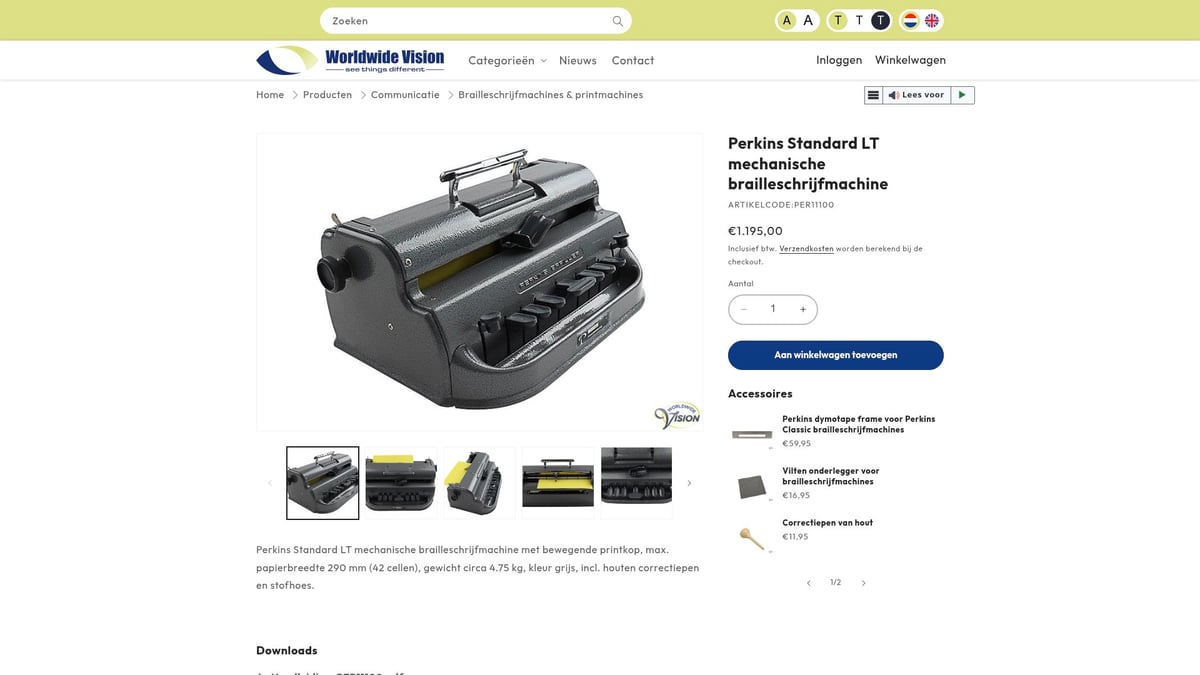
The Perkins Standard LT meets European standards for braille education and is highly suitable for schools investing in durable braille machine solutions. In Belgium and the Netherlands, this machine is recommended for primary and secondary education.
The braille machine works according to the six-dot system, where each character is formed by tactile dots. This system is the foundation of all braille signage and is recognized under European legislation (EN 17210).
The Roland UV printer allows you to print braille directly on materials such as plastic, aluminum, glass, and even wood. This digital braille machine offers speed, flexibility, and durability, ideal for signage, nameplates, and information panels.

The Roland UV printer supports different braille standards and complies with European and Belgian accessibility regulations. Increasingly, public institutions in the Netherlands and Belgium choose this braille machine to meet legal requirements.
AdFortem provides this solution, conducts test productions, and guides organizations in integrating it into existing workflows. The UV printing technology allows customization and is suitable for both small and large runs.
The Blista Standard is a compact, lightweight braille machine excelling in mobility. Thanks to its steno and standard braille format, this machine is especially popular among students and mobile users.
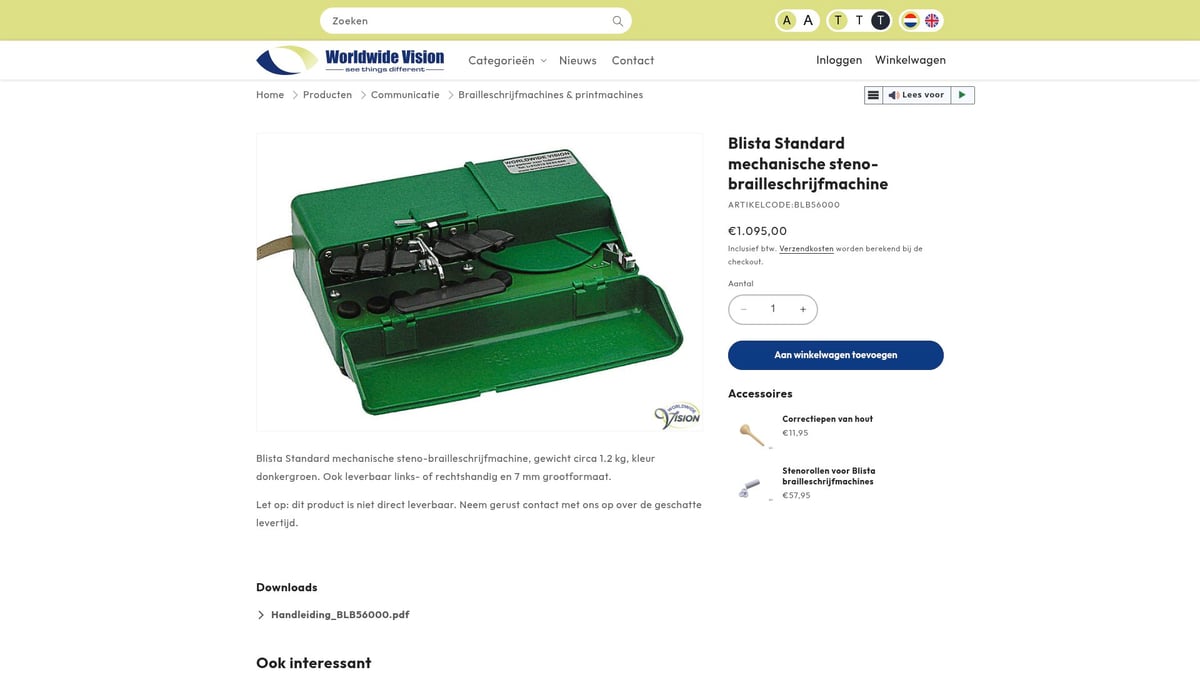
This braille machine is often used in settings where flexibility is important, such as universities and training centers. Its simple operation and low weight make the Blista Standard ideal for daily use on the go.
The use of this braille machine fully complies with Belgian and Dutch regulations, always respecting the six-dot system, ensuring correct and accessible communication.
The Gravotech braille engraving machine enables durable braille engraving into materials such as plastic, aluminum, and stainless steel. This CNC-controlled braille machine is designed for industrial signmakers, architects, and public buildings, delivering highly precise dot formation.
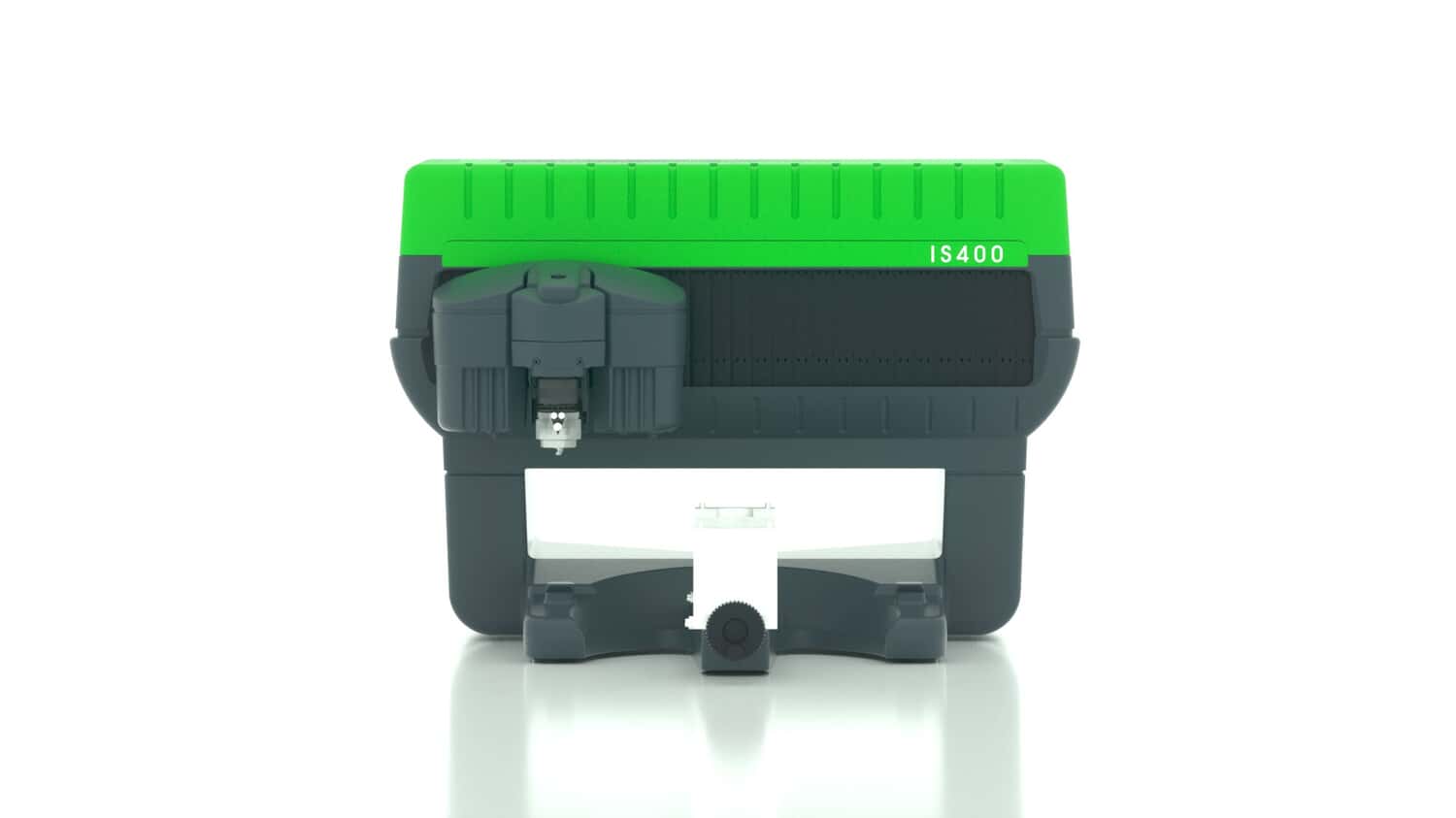
The engraving technique is particularly suitable for permanent braille signage, such as elevator panels, door plates, and industrial markings. Thanks to the versatility of the Gravotech braille machine, all European and national requirements can be met.
AdFortem supplies this solution and offers free test productions for companies seeking to meet the strictest accessibility standards. Integration with CAD/CAM software makes this braille machine ideal for custom projects and complex designs.
The Perkins Smart is an innovative braille machine focused on education and rehabilitation. Thanks to English-speaking feedback and digital memory, this machine is ideal for children and beginner braille users.
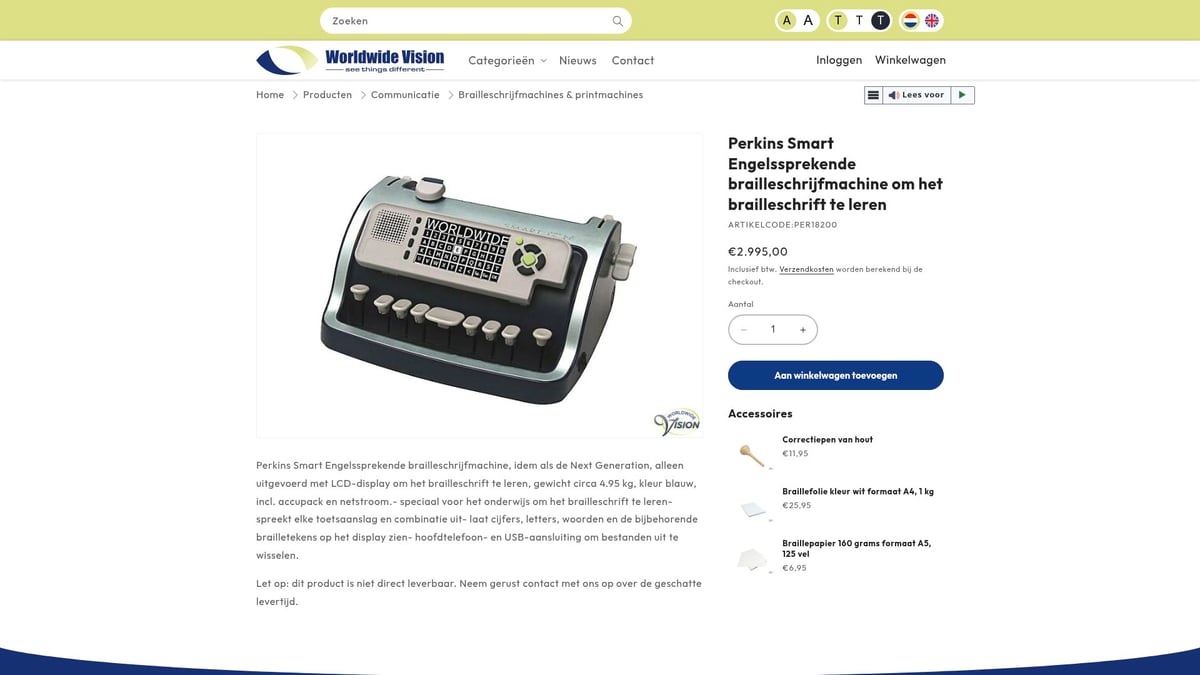
This braille machine aligns with the trend of digitalization and personalized education. In Belgium and the Netherlands, the use of digital braille solutions is increasingly encouraged, particularly in primary education and rehabilitation centers.
The Perkins Smart meets international standards and contributes to an inclusive learning environment. The auditory support helps users learn to read and write braille independently.
The Blista Eurotype is a mechanical braille machine with a European keyboard layout. It is designed for multilingual users and institutions that want to produce braille in different languages.
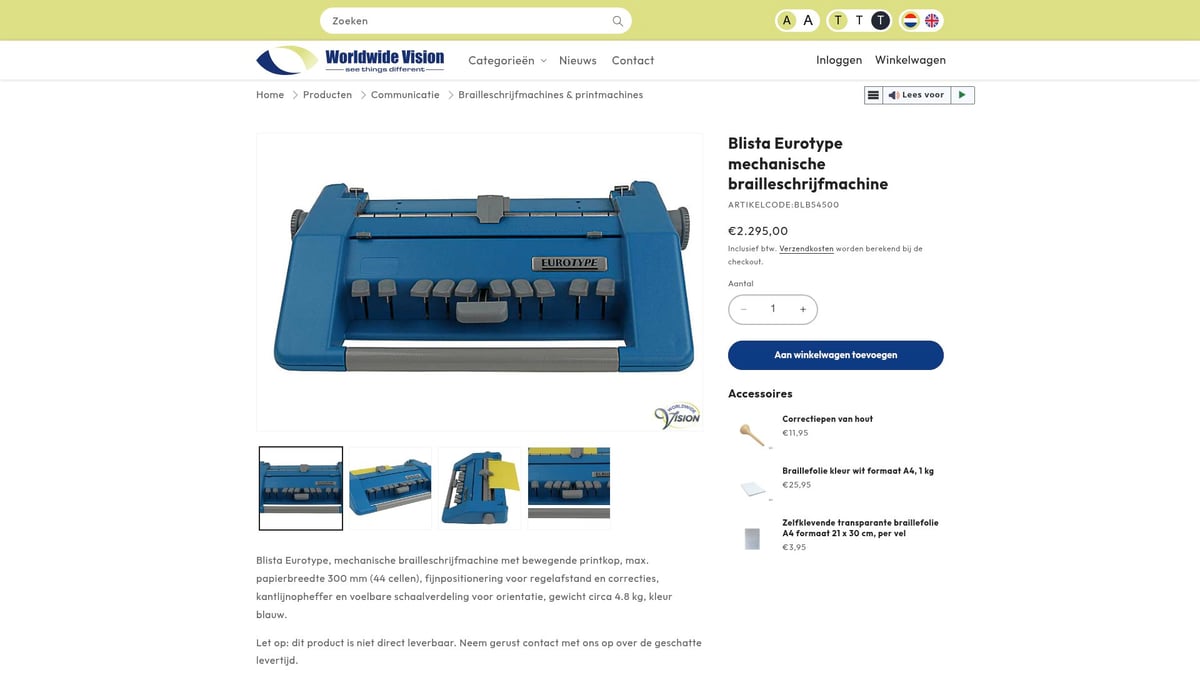
With its customizable key layout, this braille machine is particularly suitable for European institutions seeking compliance with local and European regulations. The sturdy construction ensures a long lifespan, even with intensive use.
This braille machine supports the six-dot system and complies with the EN 17210 standard. In the Netherlands and Belgium, multilingual schools and libraries primarily choose this solution.
The Perkins Unimanual is a unique braille machine for users with motor impairments. Thanks to its specially designed mechanism, the machine can be operated entirely with one hand.
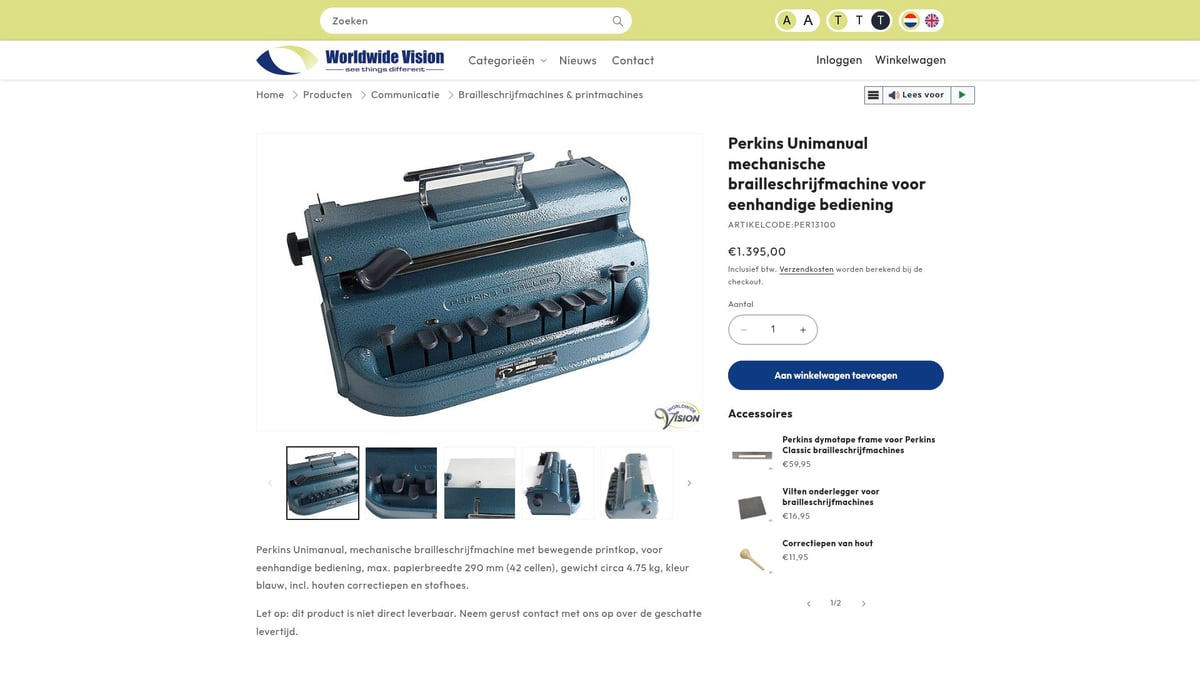
This braille machine was developed in line with growing attention to societal inclusion. In rehabilitation centers and inclusive educational institutions in Belgium and the Netherlands, this solution is frequently used.
The Perkins Unimanual helps users work independently and contributes to social participation for people with disabilities. The machine complies with all relevant regulations and supports the goal of universal accessibility.
Comparison Table: 7 Best Braille Machine Options
| Product Name | Price | Mechanical/Digital | Application | Advantages | Disadvantages |
|---|---|---|---|---|---|
| Perkins Standard LT | €1,195.00 | Mechanical | Education, Private | Robust, reliable | Not digital, heavy |
| Roland UV Printer | On request | Digital | Signage, public spaces | Flexible, fast | Investment, technical knowledge required |
| Blista Standard | €1,095.00 | Mechanical | Mobile, Education | Lightweight, affordable | Small volumes only |
| Gravotech Engraving Machine | On request | Digital | Industry, buildings | Durable, customizable | Investment, technical knowledge required |
| Perkins Smart | €2,995.00 | Digital | Education, Rehabilitation | Educational, interactive | Price, English only |
| Blista Eurotype | €2,295.00 | Mechanical | Multilingual, Institutions | Precise, ergonomic | Price, not digital |
| Perkins Unimanual | €1,395.00 | Mechanical | Rehabilitation, Inclusion | Accessible, unique | Niche, not digital |
The choice of a braille machine depends heavily on its application, budget, and legal requirements. Thanks to Roland and Gravotech solutions, provided by AdFortem, any organization can comply with the strictest European and local accessibility standards for braille signage. AdFortem supports companies in Belgium, the Netherlands, Luxembourg, and Northern France with the selection, test production, and implementation of the right braille machine, ensuring braille signage remains an essential part of inclusive communication.
The future of braille machine technology and signage is marked by rapid innovation and growing societal relevance. Globally, there is increasing awareness that accessible communication is essential for inclusivity. Braille signage is no longer merely a tool for independence; it now takes a central role in public spaces, education, and workplaces. Digitalization and automation of braille machine solutions open new opportunities for customization and personalization.
New applications, such as Braille Printing with Roland UV Printers, make it possible to print braille on a wide range of materials, from signage to nameplates and information panels. This technology offers speed, flexibility, and durability. On the other hand, Braille Engraving with Gravotech Engraving Machines provides highly precise and long-lasting braille markings in materials like plastic, aluminum, and stainless steel. AdFortem provides both solutions and allows companies in Belgium and the Netherlands to perform free tests for their braille signage projects, lowering the barrier to adopting innovative braille technology.
The six-dot braille system, where tactile points are arranged in a grid, remains the foundation of every modern braille machine. Text is converted into tangible information mechanically or electronically, depending on the chosen technology. In Belgium and the Netherlands, strict regulations govern braille signage. European guidelines such as EN 17210 impose accessibility requirements on public buildings. In countries like France, Germany, and the United Kingdom, braille signage is already legally required in many public spaces. Companies and institutions increasingly need to invest in suitable braille machine solutions to comply.
The trend toward universal accessibility will continue in the coming years. Innovations such as digital braille displays, IoT integration, 3D printing of braille, and the rise of international standards will ensure the braille machine retains a key role in society. The availability of professional solutions and the growing offer of custom options make braille signage a permanent fixture in an inclusive and accessible world.
Now that you have a clear overview of the best braille machines for 2025 and the latest developments in braille technology, you understand the importance of investing in accessible communication. Whether you are looking for a customized solution, professional advice, or are curious about the possibilities for your organization, we are happy to assist. Want to experience firsthand which braille machine best suits your needs? We are happy to provide a demonstration and show what is technically possible for your sector. Request a demo and discover the best braille solution for your situation.
No comments found.
Sign up here to receive the newsletter
Terms and conditions of sale
About us
Our mission
Privacy Policy
Coockie Policy
Blog
Roland-dealer
Gravotech-dealer
Poli-tape-dealer
Training
Our services
UV-printing
Types of ink
Types of blades for cuttingmachines
Types of engraving tools
Laserengraving, how does it works
What is MOPA
Laserengraving versus CNC-engraving
Gantry versus galvo-laserengraving
Dot Peen machines
Difference between fiber and CO2 lasers
Monomeer, polymer or cast print media
Printing gloss
Flatbedprinter
How to choose your laser lens
Sitemap